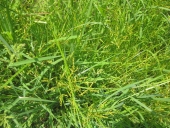




 1
1




 1
1





 1
1




Hans Albert Quistorff, LMT projects on permies Hans Massage Qberry Farm magnet therapy gmail hquistorff
 2
2




 4
4




Hans Quistorff wrote:I personally consider weeds like your oxalis winter ground cover. Here we have dead nettle, so called because it has no stingers. It grows during cold weather then then flowers and seeds in May and is dead by June. If I want to plant earlier or reduce seeding I can cut it and leave it in place for mulch. Larger seed plants and vigorous growers like kale will simply out grow it and benefit from its soil cover when it dies back. Remember soil life benefits from the sugars of living roots and decompose the dead roots so having a self sowing cover crop that dies in summer is very beneficial.
I cultivate my vegetable garden with a chicken tractor so they eat it down and redeposit it as a fast acting fertilizer. In my perennial berry rows it inhibits the sprouting of grass that will clump and crowd out the crowns. The plum trees that shade the berries are happy with anything that is shallow rooted that protects their roots from summer sun.











Hans Albert Quistorff, LMT projects on permies Hans Massage Qberry Farm magnet therapy gmail hquistorff





 2
2




Works at a residential alternative high school in the Himalayas SECMOL.org . "Back home" is Cape Cod, E Coast USA.
 3
3




Antonio Hache wrote:I’ve read this article trying to find a solution to my “oxalis problem”.
https://agendagotsch.com/en/the-syntropic-value-of-grass-goodbye-herbicide/
As I wrote in other post, I’m having “agret” (similar to clover, oxalis pes caprae) growing everywhere. Around my trees is not a problem, it will die in May and I can use it as green manure.
But it comes to my veggie beds and that is a problem as it outgrows everything. It is impossible to fight, I keep weeding , but I end up hour taking it out manually. It is boring, tiring and frustrating.
This article says: plant grass strategically between vegs, so weeds want grow and it might give another kind of benefits. Anyone tried it? What do you think?
I cant combat oxalis, so I should use new tools. Because it is unsustainable for me to spend hours weeding it
Jd
 2
2




Regards, Scott
 2
2




 3
3




With appropriate microbes, minerals and organic matter, there is no need for pesticides or herbicides.







 2
2




Hans Albert Quistorff, LMT projects on permies Hans Massage Qberry Farm magnet therapy gmail hquistorff







 2
2




Hans Albert Quistorff, LMT projects on permies Hans Massage Qberry Farm magnet therapy gmail hquistorff




Earthworks are the skeleton; the plants and animals flesh out the design.
 1
1








 1
1




 1
1




Creating edible biodiversity and embracing everlasting abundance.




Abraham Palma wrote:Last sunday I was told by a couple of old ladies that oxalis also turned the soil acidic (the oxalic acid it produces). Well, not really a concern in a mostly calcaric land, I should say. But they wanted the oxalis removed, anyways.
My crops that are taller than the oxalis leaves don't seem to care.




Hugo Morvan wrote:Hi Antonio, maybe you could try covering it with a 5cm (2 inch) layer of woodchips and what peeps through there keep chopping it off. Or people have these sandwich techniques, cardboard, straw, compost, cardboard again, straw for looks. Put stones on the side to keep it from blowing off. Then plant some things that get really big and produce shade, like cardoon or artichoke or purple headed brocolli.
Or create a physical barrier between big shading plants and the invaders. Like dig a hole and put in a plastic pot without the bottom and fill that with nice soil and a plant that will grow big. Something like cardoon or artichoke or some type of purple head brocolli or some creeping cherry tomato that towers above or a dense mini forest of giant palm kale. I am just mentioning these plants because they grew really big at my place and "light suffocate" evil spreading stuff under it. And because they are there all winter, they don't mind a bit of night freeze (we have that), they grow all winter.
I think winter where you are might be exactly the time this kind of bulbil loves, enough water around, the leaves of the trees fell of, so enough light, suck up all the light, suck up all the water, suck up all the nutrients from the fallen leaves and make many babies, happy, happy time and comes summer, just hide in the bulbil and wait it out while everything you have planted suffers and dies from heat stroke and drought. Just to feed more oxalis.
I know you've thrown many seeds around, so you might lose those with the sandwich technique. But if they don't grow because of oxalis there is no loss.
Anyway, here's hoping these are some ideas for the future.
 1
1




 1
1





|
We don't have time to be charming! Quick, read this tiny ad:
2024 Permaculture Adventure Bundle
https://permies.com/w/bundle
|



